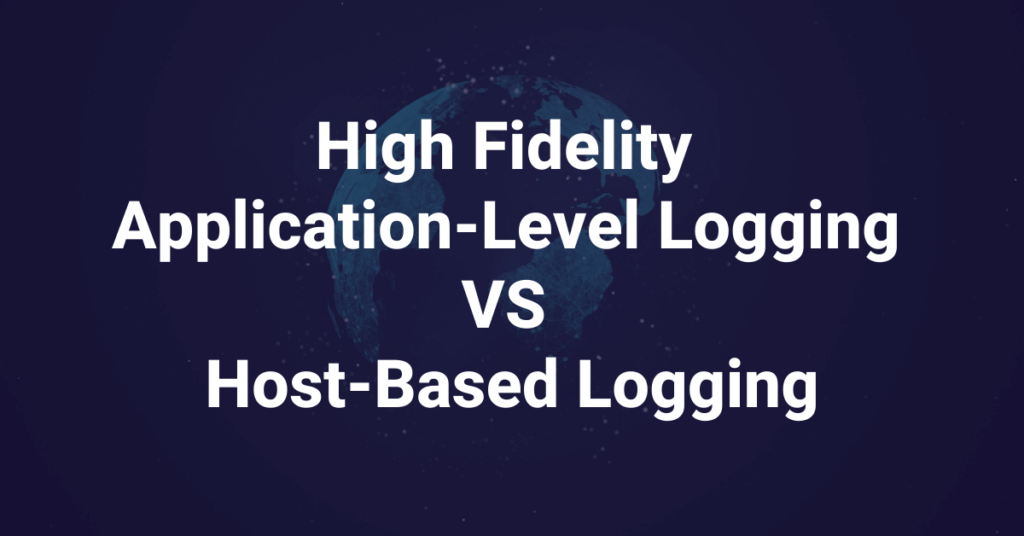High Fidelity Application-Level Logging vs. Host-Based Logging
Logging plays a crucial role in software development and system administration, providing valuable insights into the behavior and performance of applications and systems. Two commonly used logging approaches are high-fidelity application-level logging and host-based logging. This document aims to compare and contrast these two logging techniques, highlighting their respective advantages and use cases.
High Fidelity Application-Level Logging
High-fidelity application-level logging focuses on capturing detailed information within the application code itself. This technique involves strategically placing log statements at critical points in the codebase to record specific events, actions, and data. Here are some key characteristics of high-fidelity application-level logging:
1. Granular Control: Application-level logging allows developers to have fine-grained control over what information gets logged. By selectively enabling or disabling logging statements, developers can target specific areas of interest, reducing noise and improving log quality.
2. Contextual Information: Application-level logging enables the inclusion of contextual information in logs, such as request parameters, user session details, and relevant metadata. This context provides valuable insights for troubleshooting and debugging, enhancing the understanding of application behavior.
3. Application-Specific Metrics: High-fidelity logging allows developers to generate application-specific metrics by logging custom events or measurements. These metrics can aid in performance monitoring, capacity planning, and business intelligence, facilitating data-driven decision-making.
4. Modularity: Application-level logging is modular and can be tailored to specific application components or modules. This modularity allows developers to focus on different layers or modules of an application, providing detailed insights into the behavior of individual components.
Host-Based Logging
Host-based logging focuses on capturing system-level information from the underlying infrastructure where the application runs. Instead of logging within the application code, this approach relies on operating system-level mechanisms and tools to gather logs. Here are some key characteristics of host-based logging:
1. Infrastructure-Wide Coverage: Host-based logging captures logs from the entire system, including all applications and services running on the host. This broad coverage provides a holistic view of the system, making it useful for analyzing system-level issues and identifying patterns across multiple applications.
2. Low Overhead: Host-based logging can have a lower overhead compared to application-level logging, as it does not involve modifying the application code or introducing additional log statements. This makes it suitable for high-throughput systems or scenarios where performance is a critical concern.
3. Centralized Logging: Host-based logging often employs centralized log management systems, where logs from multiple hosts are aggregated and stored in a central repository. This centralization simplifies log analysis, search, and monitoring, enabling efficient troubleshooting and auditing.
4. Operational Insights: Host-based logging provides insights into system-level operations, such as resource utilization, network activity, and security events. These logs help administrators identify and mitigate issues related to system performance, security breaches, or compliance requirements.
Choosing the Right Logging Approach
The choice between high-fidelity application-level logging and host-based logging depends on the specific needs and goals of the application and system administrators. Consider the following factors when making a decision:
1. Granularity vs. System-Level Visibility: If detailed insights into the application’s behavior and internal components are crucial, high-fidelity application-level logging is preferred. On the other hand, if a broader system-level perspective is required, host-based logging is more suitable.
2. Performance Impact: Consider the performance impact of logging on the application. If minimizing performance overhead is a priority, host-based logging might be a better option due to its lower impact on application performance.
3. Contextual Information and Metrics: If capturing contextual information and generating application-specific metrics is essential, high-fidelity application-level logging provides more flexibility and control.
4. Infrastructure Management: Host-based logging is beneficial when managing logs across multiple hosts and requires a centralized log management system for efficient log analysis and monitoring.
Conclusion
High-fidelity application-level logging and host-based logging are two distinct approaches with their own merits. Application-level logging provides granular control, contextual information, and application-specific metrics, making it suitable for detailed analysis and debugging. Host-based logging offers infrastructure-wide coverage, low overhead, and system-level operational insights, making it valuable for system monitoring and management. Choosing the right logging approach depends on the specific requirements, priorities, and goals of the application and system administrators.
Contact us to Learn More




